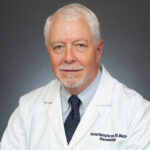 The issue of the rheumatology workforce shortage is certainly vexing. Not only does it leave large segments of the population without adequate care for patients with serious rheumatic diseases, but it also increases the burden on the few rheumatologists who serve populous, underserved regions of the country. Solutions suggested in The Rheumatologist (“ACR Workforce Solutions Committee Crafting Answers to Looming Workforce Shortage,” Dec. 6, 2022) and by the ACR are all excellent. Another potential solution for covering underserved, especially rural, regions is for rheumatologists who are considering retiring to instead work part time.
The issue of the rheumatology workforce shortage is certainly vexing. Not only does it leave large segments of the population without adequate care for patients with serious rheumatic diseases, but it also increases the burden on the few rheumatologists who serve populous, underserved regions of the country. Solutions suggested in The Rheumatologist (“ACR Workforce Solutions Committee Crafting Answers to Looming Workforce Shortage,” Dec. 6, 2022) and by the ACR are all excellent. Another potential solution for covering underserved, especially rural, regions is for rheumatologists who are considering retiring to instead work part time.
Many areas of the country devoid of access to rheumatologic care would likely be grateful to have rheumatologists even on a part-time basis. Not only does this allow for care to be provided to underserved areas, but it also allows physicians to experience being in a different part of the country and enjoy a different culture, while decreasing or eliminating the fatigue factor. This also provides an income stream so physicians don’t have to dip too deeply into their savings to continue doing whatever it is they enjoy.
I very much enjoy the practice of rheumatology, as, I am sure, most rheumatologists do. However, like many physicians, I found working five days a week every week was becoming extremely fatiguing. Now that I am working part time, I have days off to recover from my workdays and respond to emails, review labs and renew prescriptions at my leisure, which makes for a much better quality of life. I work in clinics in both New York and Maine, which allows me to experience a diversity of cultural experiences while helping underserved regions in both urban and rural regions of the country. Also, many part-time jobs do not require hospital coverage, making nights and weekends less stressful.
In summary, I would urge rheumatologists who are considering retiring due to a sense of overwhelming fatigue, but would like to continue practicing, to consider part-time employment. Even if clinics are advertising only for full-time employees in a region where a physician would desire to work, it would be worthwhile contacting the facility because it may be willing to hire a part-time rheumatologist. After all, some help is better than none.
David Engelbrecht, MD, is a board-certified rheumatologist who has been in practice since 1990. He currently runs two clinics in the Bronx, at St. Barnabas Hospital Ambulatory Care Center and Union Community Health Center. He has also been an attending rheumatologist at Northern Light Maine Coast Hospital, Ellsworth, since 2016.


